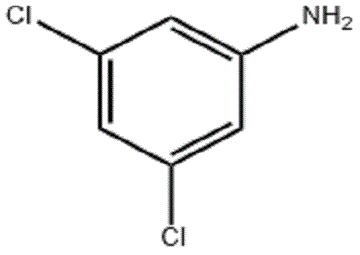English Synonyms
3,5-DCA;Phloroglucinol Impurity 26;3,5-dichloro;3,5-dichloro-anilin;3,5-dichloro-benzenamin;Aniline, 3,5-dichloro-;Benzenamine,3,5-dichloro-;BF352-31
3,5-Dichloroaniline Properties
| Melting Point | 46-52 °C (lit.) |
| Boiling Point | 259-260 °C/741 mmHg (lit.) |
| Density | 1.58 |
| Refractive Index | 1.6000 (estimate) |
| Flash Point | >230 °F |
| Storage Conditions | Store Below +30°C. |
| Solubility | Solubility in Water 0.78 g/L |
| Acidity Coefficient (pKa) | pK1:2.37(+1) (25°C) |
| Form | Crystallization |
| Color | Dark Gray |
3,5-Dichloroaniline Uses and Synthesis Methods
Use
3,5-Dichloroaniline is an intermediate of the fungicides procymidone, iprodione, vinclozolin and sclerotin.
It is used as a raw material for agricultural pesticides. It can be used to produce diclozolin, sclerotin, vinclozolin, sclerotin, iprodione, fenclofen, cloflufenac and fenclofen. ; It can also be used to synthesize herbicides and plant growth regulators. It is used in the pharmaceutical industry to manufacture quinoline derivatives for the treatment of malaria. The dye industry is used in the manufacture of azo dyes and pigments. Used in industrial hygiene to manufacture pesticides and pest repellents.
Used as pesticides and pharmaceutical intermediates.
Oil intermediates. organic synthesis.
Production Method
1. 3,5-Dichloronitrobenzene hydrogenation method 2. Polychlorinated aniline dechlorination and hydrogenation method 3. Hydrogen iodide dechlorination method 4. Ammonolysis method consists of 1,3,5-trichlorobenzene (or 1,2, 4-Trichlorobenzene) is obtained by aminolysis. 5. Decarbonylation method is prepared by decarbonylation of 3,5-dichlorobenzamide. 6. The 2,6-dichloro-4-nitroaniline method uses 2,6-dichloro-4-nitroaniline as raw material, and is produced by diazotization and hydrogenation. 7. Acetanilide method uses acetanilide as raw material. After chlorination and hydrolysis, a mixture of 2,4 and 2,6-dichloroaniline is obtained. After bromination and diazotization, 3,5-dichloroaniline is obtained. Bromobenzene is then subjected to ammonolysis to obtain the product. 8. Obtained from p-nitroaniline (or o-nitroaniline) through chlorination, diazotization (deamination) and reduction. In addition, 3,5-dichloroaniline can also be produced from p-dichlorobenzene (or o-dichlorobenzene) through bromination, isomerization, and ammoniation.


